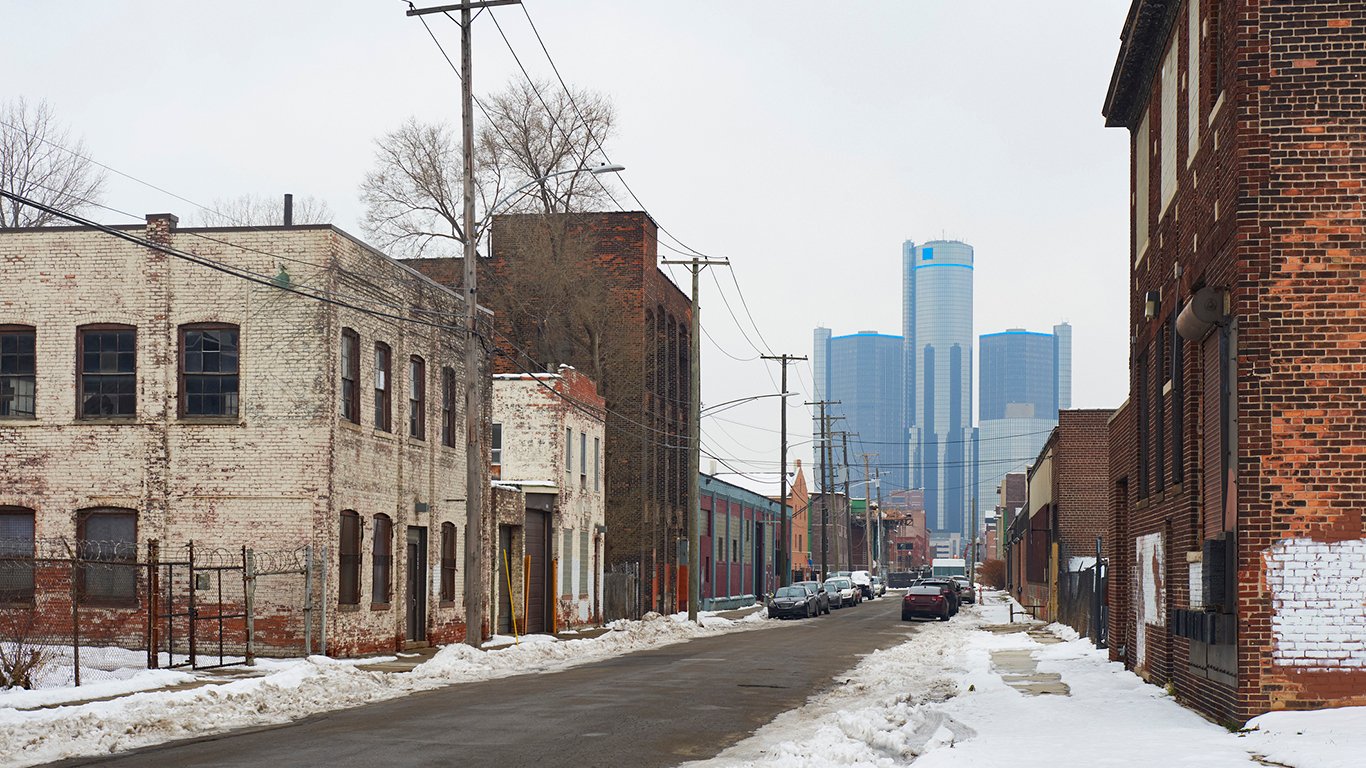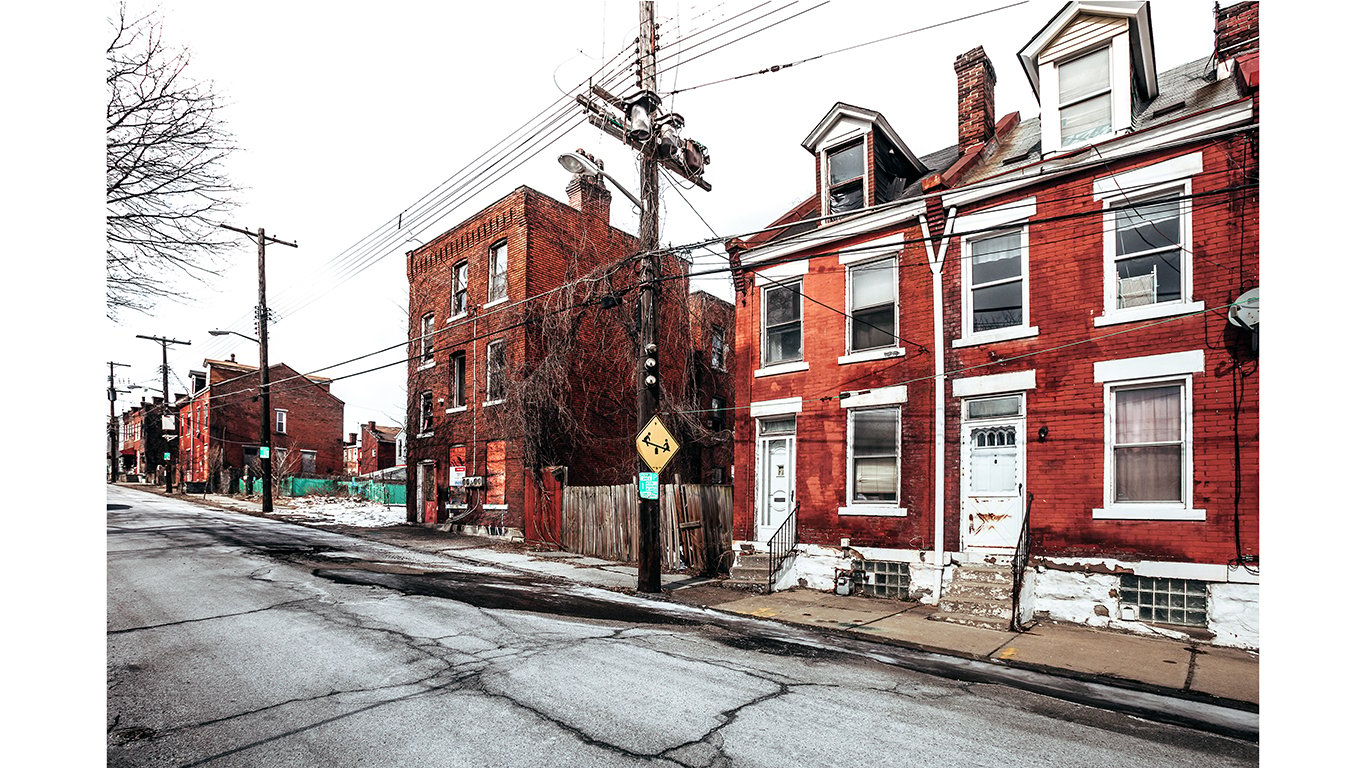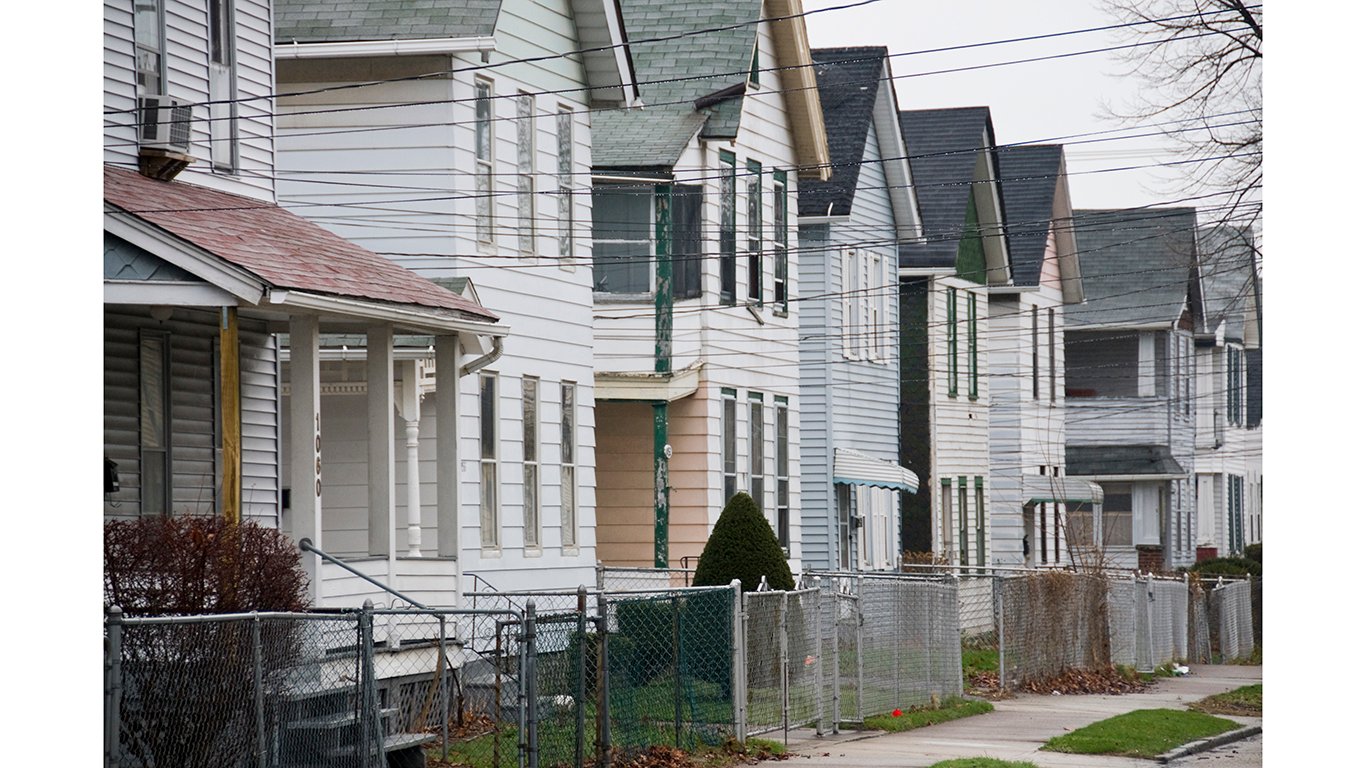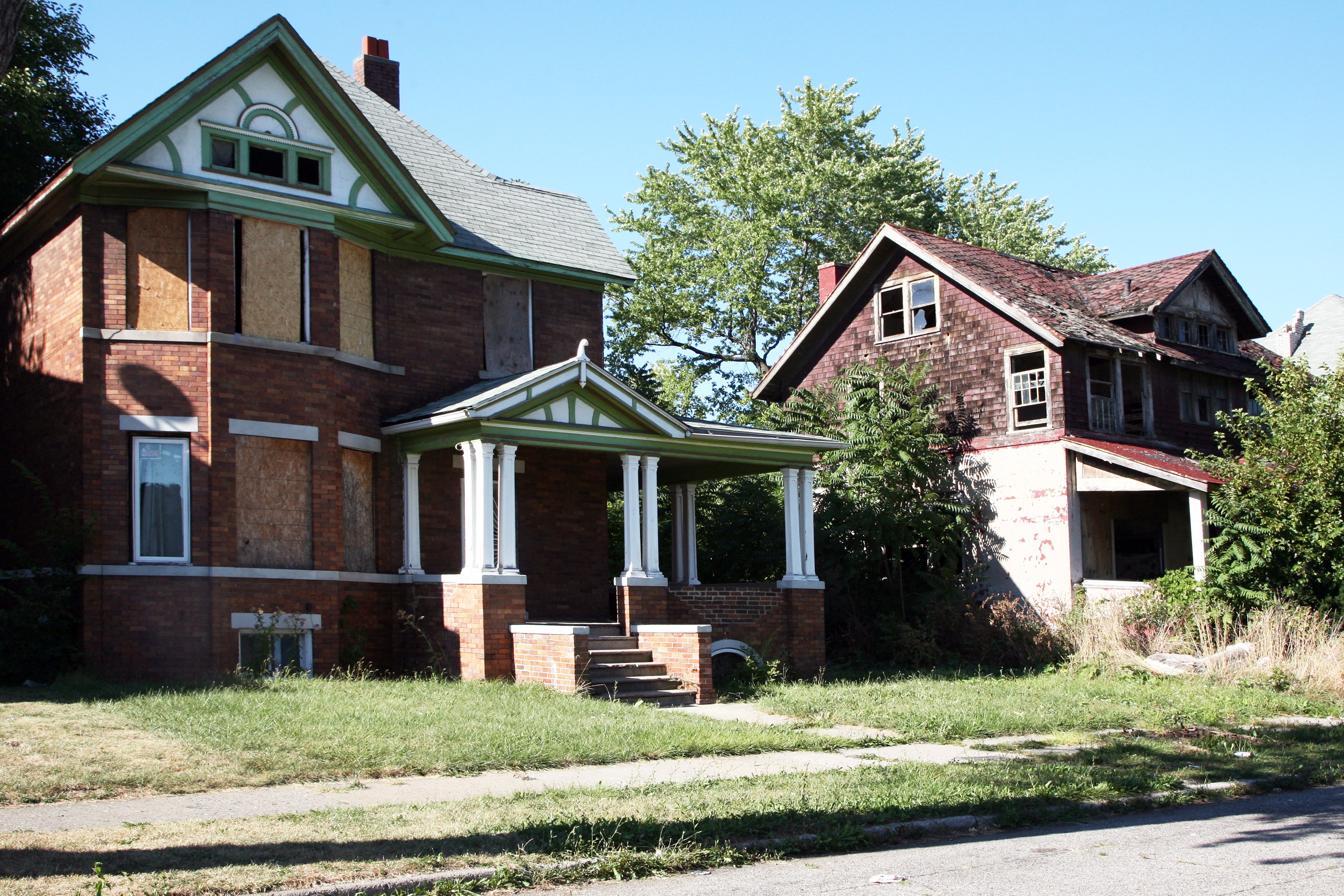

U.S. population growth hit an 80-year low of 0.6% year-over-year in 2018. The slowdown in growth — an already familiar phenomenon in some of the world’s most economically advanced countries — is largely attributable to a declining birthrate. In some of America’s cities, the population is not growing at all and is even shrinking (see our list of America’s fastest shrinking cities). In some, the severe population decline is the result of several ongoing factors that have for decades worked to decimate a city’s population.
Places like Detroit, Cleveland, and St. Louis are former industry hubs and innovation centers that were hugely prosperous by the middle of the 20th century. But by the 1970s, steel manufacturers, automakers, and other industrial giants, which were already reducing manned labor by implementing automated processes, left the Northeast, Midwest, and Mid Atlantic for the South and other countries.
Those companies, once central to the lives and well-being of these cities, closed their doors, and city residents abandoned city centers for the suburbs, or other parts of the country. As symbols of the post-industrial decline in America, these metropolises, known as legacy cities, often share the unfortunate label of Rust Belt city.
Today, residents of these cities are more likely to struggle to find work and live in poverty. SNAP recipiency rates in these five cities range from 17.3% to over 40%, compared to the national SNAP recipiency rate of 12.6%. Several of these cities are at the heart of the nation’s ongoing opioid epidemic. Many of these cities also have higher than average violent crime rates, and some even rank as the most dangerous city in their state.
24/7 Wall St. used decennial city population figures from the Center for Spatial and Textual Analysis at Stanford University and the U.S. Census’s American Community Survey to identify the five major cities that have lost at least 50% of their populations from their peak in 1950.
Click here to read about cities that have lost half or more of their populations.

5. Pittsburgh
> Decline from 1950 decade peak: -64.7%
> 1950 population: 676,806
> 2018 population: 301,048
Nearly 677,000 residents called Pittsburgh home in 1950; it was the 12th most populous U.S. city at the time. As of 2018, the city’s population had fallen to just over 300,000, ranking 66th among U.S. cities. Like most American cities with declining populations, Pittsburgh’s decline can be traced largely to the decline of American production and manufacturing that began to take hold in the 1970s and continues to affect the region today.
The city’s economic decline occurred across many industries, but the death of its once mighty steel industry was at the heart of the economic decline and population loss in Steel City. In the 1970s and 1980s, Pittsburgh’s biggest steel employer laid off tens of thousands of workers. From 1970 to 1990, the city lost over 150,000 residents. Today, the level of financial distress in the city reflects in part the economic consequences of a shrinking population. Approximately 22% of people live in poverty in Pittsburgh, and nearly 12% of households earn extremely low incomes (less than $10,000 annually) — each percentage is well above the corresponding national rate.
[in-text-ad]

4. Buffalo
> Decline from 1950 decade peak: -55.8%
> 1950 population: 580,132
> 2018 population: 256,304
The decline of many of the nation’s legacy cities can be traced to a severe but relatively gradual evaporation of an important industry, and this is also the case in Buffalo — but to an extent. The city suffered as a result of developments in transportation, which resulted in the city losing its standing as a trade route hub. Buffalo was as a major metropolis by the early 20th century due to its location at the top of the Erie Canal, which served as a hub for trade moving from the east to the west via the canal. As roadways and the interstate systems were developed, trucking became a more optimal means of shipping across the country, and barge transportation on the canal dried up. This played a key role in catalyzing the loss of over half of the city’s population as the city’s rank declined from the nation’s 15th most populous city in 1950 to the 83rd most populous today.
The city, though, may be staging a comeback, as young workers have moved to the city. However, the city still has a 30.9% poverty rate, and nearly 35% of households rely on SNAP benefits, more than double the 12.6% share of households nationwide.

3. Cleveland
> Decline from 1950 decade peak: -58.0%
> 1950 population: 914,808
> 2018 population: 383,793
Of the 64 large U.S. cities with 300,000 people or more, only five — including Cleveland — have a population that is now smaller than even just five years ago. Since 2012, Cleveland’s population declined by 2.3%, even as the U.S. population grew by 3.8% over the same period. The out-migration began long ago, however, since 1950, the decade in which Cleveland’s population peaked at 914,808.
Demographic shifts like out-migration tend to exacerbate adverse socioeconomic conditions, which themselves often accelerate population decline. Like other cities with shrinking populations, Cleveland’s violent crime rate of 1,557 incidents for every 100,000 people is among the highest in the country. The rate is five times higher than it is statewide. Ohio’s violent crime rate is 298 incidents per 100,000.
Crime is often concentrated in lower-income areas, and Cleveland is one of the poorest cities in the country. Cleveland’s 35.2% poverty rate is more than double the poverty rates of 14.9% statewide and 14.6% nationwide.

2. Detroit
> Decline from 1950 decade peak: -63.6%
> 1950 population: 1.85 million
> 2018 population: 672,662
Detroit grew dramatically over the first five decades of the 20th century — from a population of 285,704 in 1900 to 1.85 million in 1950, when it became the fifth largest city in the country. That decade, there were only five U.S. cities with more than 1 million residents. Just as the growth of heavy industry helped Detroit become the prospering automobile manufacturing capital of the world, rapid declines in the sector led to heavy job losses, mass exodus of its population, and the urban decay the city is currently known for.
As is generally the case in the five cities that have lost half or more of their populations since 1950, Detroit struggles with high violent crime and poverty rates. Detroit’s violent crime rate was the highest of any city in Michigan and more than quadruple the statewide violent crime rate of 450 incidents per 100,000 people in 2018. Nearly 40% of the population lives in poverty, the highest poverty rate of any city with a population of at least 100,000.
[in-text-ad-2]

1. St. Louis
> Decline from 1950 decade peak: -64.7%
> 1950 population: 856,796
> 2018 population: 302,838
With a population of 856,796, St. Louis was the eighth largest city in the country in 1950. The city’s population has steadily declined since then to just over 300,000 in 2018, ranking as only the 64th largest city in the United States. Like other cities with long-term population declines, adverse socioeconomic conditions are prevalent in parts of St. Louis. East St. Louis, for example, is far and away the most dangerous city in Illinois and one of the most dangerous cities in the United States. Also, one in four people living in St. Louis live in poverty, well above the national poverty rate of 14.6%.
While St. Louis may not be booming, certain aspects of the city do show signs of renewed prosperity. Relatively high immigration from Asia has helped offset some of the out-migration. The city’s sports teams, the Cardinals and the Blues, do very well, which can help support population and economic growth. And, plenty of universities and large companies still operate and thrive in the city.
Take This Retirement Quiz To Get Matched With An Advisor Now (Sponsored)
Are you ready for retirement? Planning for retirement can be overwhelming, that’s why it could be a good idea to speak to a fiduciary financial advisor about your goals today.
Start by taking this retirement quiz right here from SmartAsset that will match you with up to 3 financial advisors that serve your area and beyond in 5 minutes. Smart Asset is now matching over 50,000 people a month.
Click here now to get started.
Thank you for reading! Have some feedback for us?
Contact the 24/7 Wall St. editorial team.

